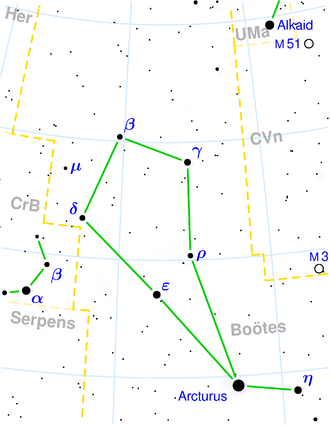NGC 5747
| Galaxie NGC 5747 | |
|---|---|
 | |
| SDSS-Aufnahme | |
| AladinLite | |
| Sternbild | Bärenhüter |
| Position Äquinoktium: J2000.0, Epoche: J2000.0 | |
| Rektaszension | 14h 44m 20,8s[1] |
| Deklination | +12° 07′ 47″[1] |
| Erscheinungsbild | |
| Morphologischer Typ | Sa + Sb[1] |
| Helligkeit (visuell) | 13,6 mag[2] |
| Helligkeit (B-Band) | 14,4 mag[2] |
| Winkelausdehnung | 0,8′ × 0,8′[2] |
| Flächenhelligkeit | 13,0 mag/arcmin²[2] |
| Physikalische Daten | |
| Rotverschiebung | 0,029684 ± 0,000033[1] |
| Radialgeschwindigkeit | (8899 ± 10) km/s[1] |
| Hubbledistanz vrad / H0 | (399 ± 28) · 106 Lj (122,3 ± 8,6) Mpc [1] |
| Geschichte | |
| Entdeckung | Wilhelm Herschel |
| Entdeckungsdatum | 15. März 1784 |
| Katalogbezeichnungen | |
| NGC 5747 • IC 4493 • UGC 9496 • PGC 52638 • CGCG 076-013 • MCG +02-38-002 • IRAS 14419+1220 • GC 3988 • H III 48 • | |
NGC 5747 ist eine 13,6 mag helle spiralförmige wechselwirkende Doppelgalaxie vom Hubble-Typ Sa + Sb im Sternbild Bärenhüter und etwa 399 Millionen Lichtjahre von der Milchstraße entfernt.
Sie wurde am 15. März 1784 von Wilhelm Herschel mit einem 18,7-Zoll-Spiegelteleskop entdeckt, der sie dabei mit „eF ... an eF neb., it is S and required some time to look at it before it could be well seen“[3] beschrieb. Auf Grund eines Fehlers in Herschels Positionsangabe führte die Beobachtung von Guillaume Bigourdan am 12. April 1898 unter IC 4493 zu einem Eintrag im Index-Katalog.[4]
Weblinks
- NGC 5747. SIMBAD, abgerufen am 17. April 2016 (englisch).
- NGC 5747. DSO Browser, abgerufen am 17. April 2016 (englisch).
Einzelnachweise
Auf dieser Seite verwendete Medien
Autor/Urheber: Sloan Digital Sky Survey, Lizenz: CC BY 4.0
The sky image is obtained by Sloan Digital Sky Survey, DR14 with SciServer.
Angle of view: 4' × 4' (0.3" per pixel), north is up.
Details on the image processing pipeline: https://www.sdss.org/dr14/imaging/jpg-images-on-skyserver/



